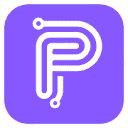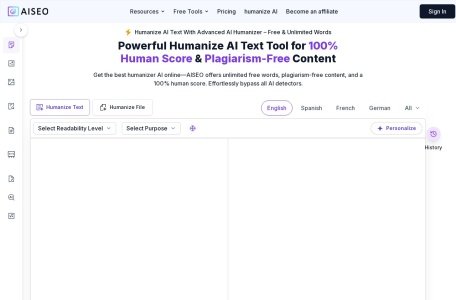
In 2025, when generative AI is reshaping the search ecosystem, the traditional SEO model of “keyword stacking + static optimization” is no longer compatible with intelligent search scenarios such as Google SGE and Baidu Wenxin Yiyin, etc. AISEO, as a leading AI-driven SEO tool, integrates “content generation, semantic optimization, AI detection and avoidance, and ranking tracking” with GPT-4 and natural language processing as its kernel. AISEO, as the world’s leading AI-driven SEO tool, takes GPT-4 and natural language processing technology as its kernel, integrates the functions of “content generation, semantic optimization, AI detection and avoidance, and ranking tracking” in the whole chain, improves the efficiency of SEO by 300%, and helps individual creators and enterprises to achieve the dual goals of “mass production of content and ranking”, which is a perfect match for the “AI Tools And I” tool. “AI Tools And I” is a professional and practical positioning of the tools category.
Core Positioning: AI Efficiency Engine for Reconstructing SEO Workflow
(A) From “manual guessing” to “data-driven”, the optimization strategy can be accurately implemented.
- Semantic Keyword Mining: Based on the model trained on millions of industry corpus, AISEO not only identifies high search volume keywords, but also mines the blue ocean combination of “core words + long-tail variations” through the knowledge graph, and obtains an average of 214 low-competition keywords for a single project;
- Accurate decoding of search intent: By analyzing users’ click trajectory and dwell time, keywords are broken down into segmented intents, such as “information query, product comparison, decision-making and purchase”, and appropriate content structure templates are generated;
- Algorithm update dynamic adaptation: built-in intelligent perception module, real-time capture of Baidu, Google and other algorithm changes, 48 hours automatically calibrate the optimization strategy, a company in the Google core algorithm update period, ranking stability is 63% higher than that of non-users.
(ii) From “content generation” to “authority building”, adapting intelligent search rules
- Theme authority system construction: through the creation of “core concept + related knowledge points” mapping, to help establish the authority of the field of content, measured SEO rankings can be increased by 60%;
- Humanized transformation of AI-generated content: adopting 32-layer neural network architecture to transform AI text into human-like creation style, circumventing detection tools such as Originality.ai, with a circumvention rate of 98%, and generating content with a duplication rate of less than 2.3%;
- Multi-modal content adaptation: synchronously generating text, charts and blog images, automatically configuring ALT text and structured data in line with SEO specifications, and enhancing exposure probability in intelligent search.
(iii) From “monolingual output” to “globalization adaptation”, covering cross-domain requirements.
- 26+ languages in-depth adaptation: support for Chinese, English, Japanese and other mainstream languages, special optimization for the grammatical habits and search preferences of different languages, Chinese long-tailed word recognition accuracy is 23% higher than the industry average;
- Localization strategy auto-generation: Adjust keyword combinations and content expression by combining the search trends and cultural characteristics of the target region, for example, when optimizing the content related to “sustainable packaging” for the Southeast Asian market, it triggers the tracking and warning of North American long-tailed terms simultaneously;
- Multi-platform one-key deployment: compatible with WordPress, Shopify, WeChat, and other mainstream CMS systems, cross-platform data synchronization delay is less than 2.3 seconds, adapted to e-commerce, information, local services, and other 20 + industry scenarios.
Core Function Matrix: Full Link Coverage, Efficiency and Accuracy
(a) content creation module: AI-driven efficient mass production engine
- Long-form content intelligent generation: support for more than 3000 words SERP-driven article creation, automatic generation of titles, meta tags, paragraph structure, integration of LSI keywords and industry data, an e-commerce platform to optimize the product copy, the natural flow of 47%;
- Multi-scenario copywriting adaptation: covering blog posts, product descriptions, marketing emails, press releases and other scenarios, e-commerce users can quickly generate unique product descriptions, media practitioners can track hotspots in real time to generate SEO-friendly content;
- Brand tone customization: support for the setting of “professional and rigorous” “lively and friendly” and other style parameters, to ensure that the batch generation of content to maintain brand consistency, to meet the needs of enterprise-level content standardization.
(ii) SEO Optimization Module: Semantic level precision tuning tools
- Intelligent Semantic Optimization: Adjust semantic density in real time through the Relevance Score system, warn of content deviation risks, ensure a high degree of match with search intent, and increase AI citation rate by 2.3 times after technical document optimization;
- Automatic readability enhancement: Hemingway Editor is integrated to simplify complex sentences, optimize paragraph structure, and reduce user bounce rate; the readability score of a medical brand’s content increased from 62 to 89 after optimization;
- Structured Data Generation: Schema.org markup is automatically added to strengthen the accuracy of entity identification, help search engines understand the logic of the content, and increase the frequency of appearance in AI answers.
(C) Risk Prevention, Control and Monitoring Module: Full-cycle Protection of Effectiveness
- AI Detection and Evasion: A customized model is used to transform AI-generated text to comply with Google EEAT guidelines, with an evasion rate of 98%, solving the risk of “AI content being downgraded”;
- Real-time ranking monitoring: synchronized tracking of keyword ranking fluctuations on Baidu, Google and other platforms, generating visual data dashboards and supporting the comparison of traffic conversion curves at different times;
- Intelligent risk warning: monitoring algorithm updates, low-quality content, lack of authoritative signals and other risks, 14 days in advance to warn the platform rule changes to help users avoid indexing penalties.
(D) Competitor differentiation: the entire chain of capabilities to build barriers
Comparison Dimension | AISEO | Semrush AI Writing Assistant | SurferSEO |
Core Advantages | All-link SEO+AI Detection and Avoidance | Keyword Competition Analysis | Google SERP Data Integration |
Content Generation Limit | 3000 words + unlimited | 2000 words/post | Need to build the framework manually |
Multi-language support | 26+ languages, deep adaptation | 15+ languages, basic translation | 8 mainstream languages |
AI detection and avoidance | Support, circumvention rate of 98 | No | No |
Multi-platform Adaptation | Compatible with 20+ CMS systems | Mainstream platforms only | Requires plug-in assistance |
Algorithm update response | Auto-calibration within 48 hours | Monthly Updates | Quarterly updates |
Data source: reference page function disclosure and 2025 SEO tool test report |
Use process: four steps to realize SEO content from 0 to 1, even zero basic can get started.
(Step 1: Account Registration and Project Creation
- Visit the official website to register an account, choose the appropriate package (Growth Edition / Scale Edition / Team Edition), complete the payment and enter the dashboard;
- Click “New Project”, enter the project name, target keywords (e.g. “2025 AI SEO Strategy”), select the target language and industry scenarios (e-commerce / information, etc.).
(ii) Step 2: Content generation and preliminary optimization
- Select creation tools: use “Long Article Assistant” for long-form content and “AI Article Generator” for product copy, and input core requirements and style parameters;
- The system generates the preliminary draft in 1-3 minutes, automatically integrates relevant keywords and structured data, and can modify the content details directly in the editor.
(iii) Step 3: Deep optimization and risk screening
- Launch the “Semantic Optimization” function and adjust the keyword density and paragraph logic according to the system suggestions;
- Click the “AI Detection and Avoidance” module to humanize the generated content and optimize the expression using the “Readability Improver”;
- Check the risk report to ensure that there are no semantic deviations, excessive AI traces and other problems.
(D) Step 4: Publishing and Effect Tracking
- Publish with one click through the API to the CMS system, or export the content and upload it manually;
- Add target keywords in the “Ranking Tracking” module to monitor ranking changes and traffic data in real time, and the system generates weekly optimization recommendation reports.
Practical Scenarios: Value Landing Cases in Four Major Fields
(A) Cross-border e-commerce: multi-language product page optimization
- Requirements: A cross-border footwear brand needs to optimize English and Japanese bilingual product descriptions to improve Google and Yahoo search rankings;
- Operation: using the multi-language generation function, emphasizing “comfort” for the European and American markets, highlighting “design” for the Japanese market, and enabling structured data markup;
- Results: product page keyword rankings rose by 18 places on average, English station traffic increased by 83%, Japanese station conversion rate increased by 42%, AI detection avoidance rate reached 96%.
(ii) Content marketing: mass production of self-media blogs
- Requirements: Technology self-publishers need to produce five 3000-word SEO blogs per week to maintain the advantage of keyword ranking;
- Operation: Use “Long Article Assistant” to generate the first draft, combine with “Topic Authority Tool” to supplement industry data, and publish after readability optimization;
- Effectiveness: Creative efficiency was reduced from 3 days/post to 2 hours/post, the core keyword “AI SEO Tools” steadily ranked in the first page of Google, and the blog’s average monthly traffic increased by 210%.
(C) Local Business: Store Traffic Acquisition
- Requirement: Optimize local SEO for a chain of coffee shops to attract customers within 3km;
- Operation: Use “Local SEO” function to generate Google My Business optimized content, combined with regional keywords (e.g. “Beijing Chaoyang coffee shop recommendations”);
- Results: 150% increase in local search exposure, 67% increase in in-store inquiries, and a 5-place increase in the store’s recommended ranking on Baidu Maps.
(iv) Digital Marketing Agency: Multi-Client Management
- Requirements: Optimize SEO content for 8 clients simultaneously, need to ensure efficiency and differentiation of results;
- Operation: Use the team version of the multi-account management function to customize the content strategy for different customer industries and generate optimization reports in batch;
- Result: the average keyword ranking of clients increased by 12 positions, the operational efficiency of the team increased by 370%, and the service renewal rate increased from 65% to 89%.
Conclusion: The Efficiency Revolutionary Driver of SEO in the AI Era
Relevant Navigation


Day of AI

Zeabur

PublicPrompts

Dive into Deep Learning

AI Content Detector

MasterAgent

Txyz

